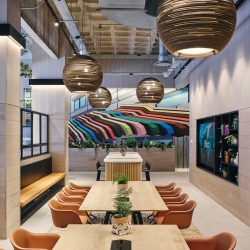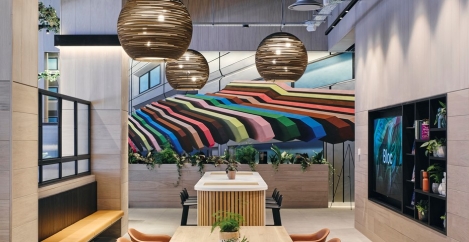August 17, 2021
Return to office doesn’t mean occupiers have lost sight of flexibility, claims report

Offices will repopulate over the remainder of this year, led by small companies – those with fewer than 100 employees, according to the EMEA Occupier Survey of 130 companies from real estate advisor CBRE. The survey found that small companies are further advanced in their return to office. Over 80 percent of small companies report all locations are now open. This compares with only a third of the largest companies, although a majority of them have opened more than half of their sites.
The study also highlights differences by sector in the return to office based work. Over 70 percent of life sciences companies report full reopening of offices, partly reflecting the difficulty of working from home in this sector. Banking & finance (57 percent) and technology, media & telecom (TMT) (46 percent) are reopening at a slower pace.
The survey claims that the majority of companies, and nearly 80 percent of larger businesses – those employing more than 10,000 employees – are leaning towards some form of mixed or hybrid working pattern. Over two-thirds of companies favouring a hybrid model say their policies and approach have been set through consensus at corporate level.
The office will continue to play a central – though different – role in how work gets done. Very few of the companies surveyed plan a fully remote solution and office-based work continues to feature prominently in their plans. Nearly 80 percent of corporates expect to settle on a workplace policy where work is either fully or mostly done at the office, or equally split. Only 15 percent of companies expect a fully remote solution.
Great expectations
Companies are evenly balanced in their expectations for changes in portfolio size, with a third expecting to expand the amount of space they occupy over the next three years. TMT companies are particularly optimistic, with over 60 percent expecting an expansion in their portfolios. Expectations in banking & finance are much more balanced; the same proportion (just under 30 percent) are planning for expansion as well as contraction, while a solid 40 percent that expect no change.
The value occupiers place on flexibility will continue to rise, partly in response to near-term economic uncertainty but also for more strategic reasons. When asked about the percentage of flex space making up the company portfolio, businesses that have between 11-50 percent of their portfolio in flex space, expect to see that percentage double over the next two years. Medium-sized companies and the TMT sector look particularly partial to the flex-space approach.
[perfectpullquote align=”right” bordertop=”false” cite=”” link=”” color=”” class=”” size=””]Large companies are increasingly willing to experiment with different space types[/perfectpullquote]
“Two compelling reasons emerge for the rising popularity of flex,” says Richard Holberton of CBRE. “Its use as a way of evaluating different occupancy models, and as a means of providing employees with more choice over work location and environment. The second of these is a particular driver for large companies and they are increasingly willing to experiment with different space type combinations and reconfigure space to reflect evolving employee preferences and learnings from initial pilots.”
When looking more broadly at factors that influence building selection, three factors dominate: flexibility, wellness and sustainability, especially air quality. Around 40 percent of companies highlight sustainable design as a key factor, on par with those that value technology integration and 54 percent cite indoor air quality. Large companies give the most importance to the full range of building amenities, consistent with the far-reaching changes in work practices and portfolio strategy that some are considering.
As companies move closer towards resuming office-based work, restoration of the features that may have been eroded during lockdowns are clearly top of mind, principally collaboration, engagement and fostering a strong corporate culture. The main implications for the workplace are enhancing or increasing collaborative areas (36 percent), piloting new workplace strategies in select locations (33 percent) and revisiting design standards (22 percent).
Companies recognise that there are also technology needs associated with anticipated changes in workstyle. Enhanced video conferencing is by far the most popular (67 percent) with smart building systems and sensors (31 percent) and air quality sensors (25 percent) also attract significant interest.
Richard Holberton concludes: “It needs to be recognised that achieving workplace goals will require more than physical design solutions, and that these need to go hand-in-hand with organisational, behavioural and leadership shifts. Given the length of time under which ‘forced’ remote working conditions have prevailed, this is more likely to be a gradual than an immediate process.”













